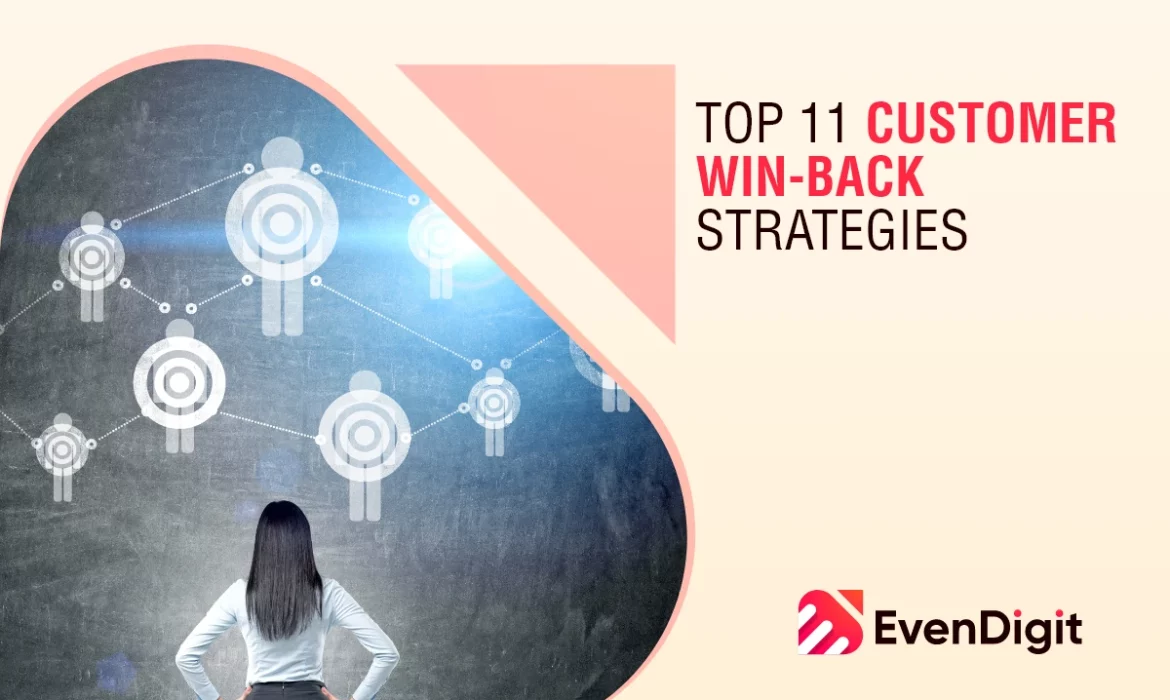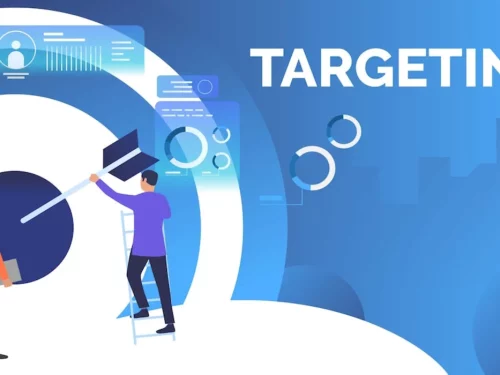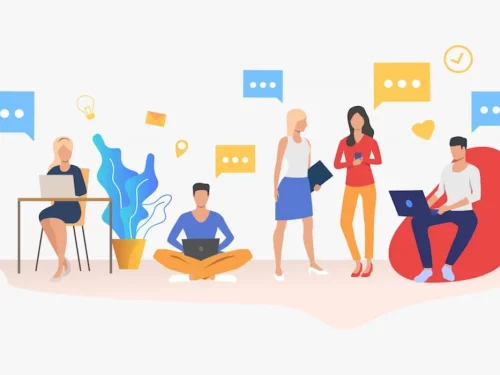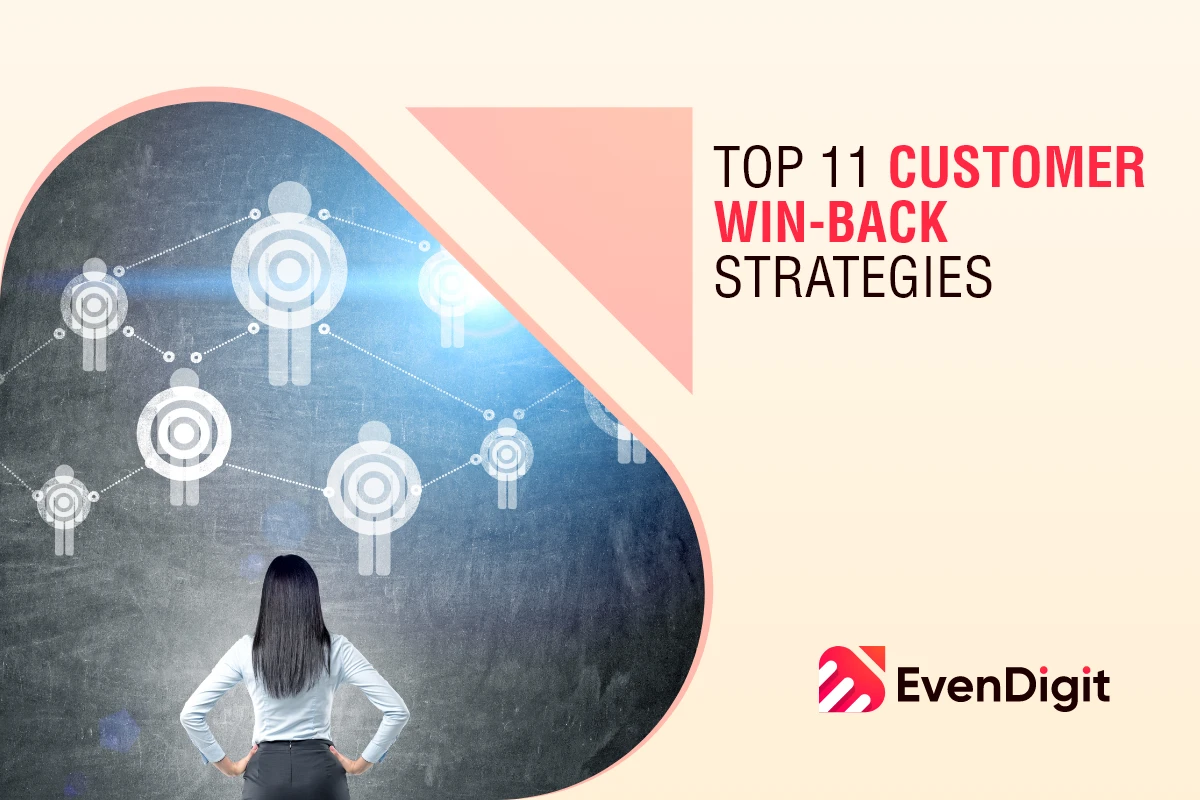
A win-back campaign with double customer lifetime value can bring back 26% of lost customers. The average customer win-back rate is 20-40%, depending on the industry and the approach used. It’s 50% easier to sell to an existing customer than to nurture and convert a new one. Offering a special promotion or discount can increase the chances of winning back a customer by up to 50%.
The modern advertising industry scatters customers’ attention around, and so, businesses are finding it harder to retain customers. Because of online and social media, customers can easily find the products and services of their competitors, making it more difficult to compete for businesses. You can expect your customers to switch to a competitor within a short period of time if they are dissatisfied with your product.
You can learn more about how to win back lost customers by reading ahead!
What is A Customer Win-back Strategy?
This type of customer marketing strategy aims to regain lost customers for your organization, also known as reactivation or re-engagement campaigns. Customers are re-engaged through a customer win-back strategy through offers, rewards, or incentives to encourage new and repeat purchases.
This is a calculated win-back marketing plan to bring back churned customers, retain their business, and reduce overall churn. Customer win-back strategies typically involve analyzing data, understanding the customer’s problem, highlighting the benefits offered, and sending messages expressing regret.
Looking For Online Marketing Agency to Grow Your Business, Let’s Connect.
Why is Customer Loyalty Important?
Customers who are loyal to a brand or business make repeated and consistent purchases from them. This increases profits, reduces marketing costs, and increases brand recognition.
A business benefits from customer loyalty in several ways.
First, loyal customers tend to spend more on the products and services provided by the company, increasing revenue.
Second, loyal customers are less sensitive to price changes, making the business more profitable. Moreover, loyal customers tend to spread the word about the brand, resulting in increased exposure and prospects.
Third, the benefit of keeping loyal customers is that businesses do not have to spend money on costly marketing campaigns.
How to get old customers back is easier when you have loyal ones who trust your brand.
Customer loyalty can also impact a company’s reputation. Loyalty often results in positive feedback and testimonials, which enhance a company’s credibility and image. In addition to generating new customers and higher profits for a business, a strong customer base will also make them more trustworthy and reliable.
Why Did They Churn?
The churn rate of your customers can be a great way to gain valuable insight into how your customers feel about your business and how to improve customer success. A positive churn, for example, occurs when the desired outcome is achieved, while a negative churn occurs when the expected outcome is not achieved.
To keep customers satisfied or win back old ones, you need to understand why customers churn. Although there are many factors that influence customer churn, these motivations are generally the main reasons:
• No or failed onboarding
• The solution is no longer required
• Key personnel has changed
• The customer found cheaper alternatives
• Poor customer service
• Limited perceived value
• Lacking market fit
• Did not provide sufficient value
• Involuntary churn (i.e., an automated payment fails, resulting in a subscription cancellation). Several personal reasons (e.g., moving to a new area, having less money, etc.).
Why Do Customers Leave?
Understanding why customers leave is just as important as understanding how to get a customer to come back. Often, a lack of communication or perceived indifference on the part of the company can result in a loss of customers. A win-back campaign strategy becomes crucial here as it can help re-engage these customers.
The rise of social media has made it easier than ever for customers to voice their dissatisfaction, potentially leading to a loss of trust in the brand. Customers might leave simply because they’ve found a better offer elsewhere. Herein lies the opportunity for a well-executed win-back strategy to regain lost customers.
How to Retain Customers in the Long Run
In the world of business, customers are the lifeblood of any enterprise. A robust customer win-back strategy is crucial for long-term success, and yet, it’s a challenge that continues to perplex many. Understanding the value of each customer relationship is the first step in any successful win-back strategy.
In fact, a report by Bain & Company suggests that a 5% increase in customer retention can lead to a 25%-95% increase in profits. Hence, understanding the value of each customer relationship is the first step in a successful retention strategy.
Strategically employing a customer win-back strategy becomes essential, particularly when competition is high. By using data-driven insights to personalize offers and services, businesses can engage customers and build loyalty. Studies show that 91% of customers are more likely to shop with brands that provide relevant offers and recommendations. Therefore, companies need to prioritize excellent customer service, as a strong customer service ethos forms the backbone of customer retention.
Is it worth winning back all lost customers?
Before you deep dive into “how to win back lost customers”, another important question to pay attention to is – “Is it worth winning back all lost customers?”
The most effective business strategies revolve around strategies to win back lost customers. It is easier to re-engage and retain lost customers because they are already loyal to your brand. Customer loyalty, repeat purchases, and satisfaction can be improved as a result.
In many cases, it is more cost-effective to gain lost customers than to acquire new ones. Research has shown that acquiring a new customer costs five times as much as retaining an existing one, so getting customers to come back can be more cost-effective.
Through customer retention through social media, companies can maximize their return on investment and increase their bottom line.
The business might not be able to win back these customers if the reasons were out of its control, such as economic or personal reasons. However, it is still important to consider the reasons why customers may have left. It may, however, be worth putting in the effort to get back a customer if the loss has been caused by poor customer service, a lack of attention, or inferior products.
Why Should You Care About Winback Campaigns?
A well-crafted win-back campaign strategy offers a multitude of benefits:
Increased profitability: A win-back campaign strategy can be more cost-effective than acquiring new customers, boosting your bottom line.
Boost to Customer Lifetime Value (CLV): Implementing strategies to win back lost customers can significantly increase their CLV.
Brand Loyalty: How to win customers back with the right approach helps re-establish trust and foster brand loyalty.
Positive Word-of-Mouth: Customers who feel valued and appreciated are more likely to speak positively about your brand, effectively attracting new customers.
Increased Market Share: Win-back campaigns can help regain market share by re-engaging customers who have drifted to your competitors.
Insights for Improvement: A win-back campaign can provide valuable insights into why customers initially left, helping you address these issues.
Enhanced Brand Image: A win-back campaign shows that your brand values its customers, enhancing your brand’s image.
11 Customer Win-Back Strategies That Work
1. Ask why they left
Getting in touch with your former customers can help you determine why they left. By targeting common pain points, you will be able to increase retention across the board. You can let them know you value their business and want to know why they left and how you can win them back.
Get feedback from your customers to gain a better understanding, but in order to get lost customers back, you must take action.
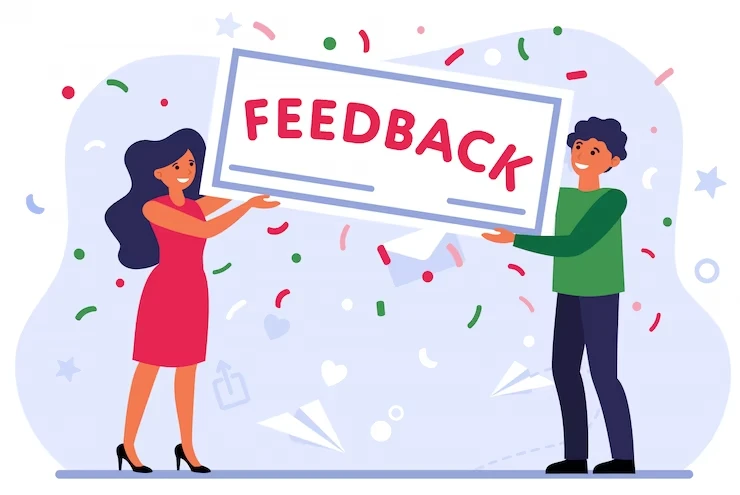
Example:
Scoot, when observed that a few of its customers have not used the platform for a while decided to conduct a survey to ask them why. Their subject line was,” we’d love your help,” indicating that their customers are valuable sources who can help them. Furthermore, they mentioned the purpose of sending emails informing customers that they are not writing simply for their own benefit instead they are ready to hear what troubles their customers.
This type of direct communication prompts their customers to act which ultimately helps Scoot in serving their customers better.
2. Engage with your customers
Keeping in touch with your customers on a regular basis will demonstrate your commitment to their needs. A variety of surveys are available, and they ask questions like, “Would you recommend our business to others?”
Your main goal should be to fulfill all their needs and deliver complete satisfaction.
3. Encourage their contribution
Your customers can be encouraged to share their experiences with you by giving them a reward in exchange for voicing concerns or providing feedback to you, which will encourage them to share their experiences with you in the future.
4. Measure customer satisfaction
Having your sales and service teams measure customer expectations and set goals to meet those expectations will help them to perform at their best. Metrics reflect how your customers feel, but only in a generic way.
Integrate customer surveys within your sales platforms for them to be most effective.
5. Personalize communication
A personal message should be sent out to the lost clients, expressing genuine interest in their needs and concerns, as well as providing support and assistance in resolving any issues they may have had with the service, which should be followed up with after they have lost contact with you.
Example:
ATGSTORES, a home furnishing brand, uses the subject title line “A lot has changed since you’ve been gone” in their win-back email. These types of subject lines can make customers realize they have been inactive for a while. The brand also mentions that they have had a lot of new things added to their store ever since the customers left. Thus, reminding them to check their store once again. Not just this, they also kept a discount to ensure that their customers take a genuine interest in exploring their new products.
6. Create a customer service-centric environment
Customer service and sales should work together to earn bonuses, and bonuses should not just be based on sales figures. Employees should be rewarded not just for their sales but also for providing excellent customer service.
Customer service should be a top priority, and success stories should be shared among employees. You cannot fake customer experiences unless you devote resources and strategies to them.
7. Reward customers
You can win back the loyalty of your customers by giving them special discounts and incentives. These can be in the form of loyalty programs, bonuses, or a once-in-a-lifetime special offer that could last for a limited period of time.
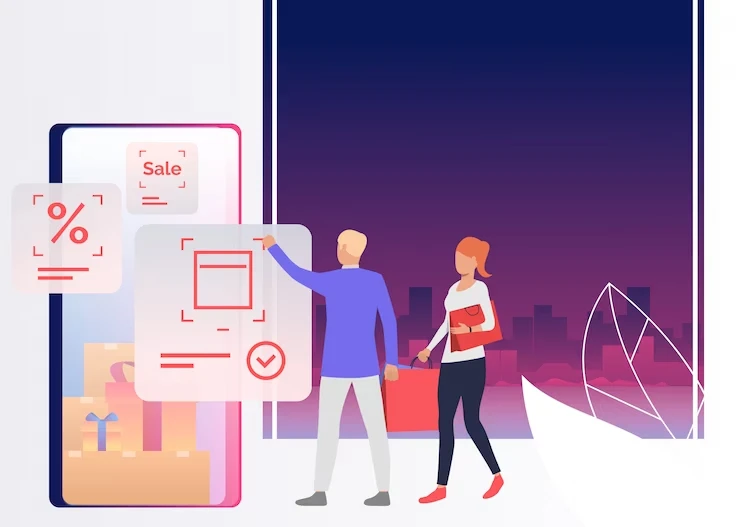
Example:
Audible gives a 45% discount on three months membership to make its customers return. In their mail, they also educate customers about the Audible membership on services like what they will get.
In addition to this, they clearly state that customers can cancel their membership anytime they wish. Thus, giving their customers the freedom to choose and make a fair deal.
8. Use social media
The use of digital channels such as social media is a great way to get in contact with lost clients, share content that highlights how the service can be of value to them, and engage them in online conversations to let them know the value of what you do.
9. Give lost customers an incentive and special promotion to come back
You can also entice customers to buy by offering special promotions. You can give them coupons or discounts they would not normally purchase. After they convert, you can send them targeted, personalized ads.
Retargeting ads emphasize the benefits your business can offer and how your services outweigh your competitors. Include case studies and glowing reviews.
Example:
Birchbox, a beauty brand, sends an incentive email to their lost customers offering them a lucrative deal. Their subject line says,” We have something for you…” creating a sense of feeling in customers’ minds that they may lose the deal if they ignore their mail.
In their win-back mail, Birchbox promises to treat their customers with a FREE product which is a must-have for make-up lovers. They also mention the original price of the product and give them a choice to pick their own design for the French sole box. These details make customers think that it’s a win-win deal. All they have to do is to grab the offer and seal the deal.
10. Analyse first-party customer data on your site
Through the analysis of your first-party customer data, your website can help you regain lost customers. A website can serve as an invaluable tool for analyzing your customers’ behaviors and habits.
By analyzing their habits, you can identify where they may have dropped out of your marketing funnel. With first-party data, you can collect information directly from your audiences, including their names, addresses, interests, and devices.
11. Use retargeting ads
A retargeting ad lets you readvertise to customers who visited your brand’s website or content but did not purchase. With retargeting ads, you can win back lost customers, giving you that extra push to entice them to buy your product again.
When these personalized, targeted ads inspire a sense of urgency in customers, they will be more likely to act quickly about purchasing a product they were considering previously.
By retargeting your customers, you let them know you’re waiting for them a second time so they don’t walk away empty-handed.
Win Back Website Visitors with Retargeting Ads
How to win back customers with retargeting ads is one of the most effective tactics in digital marketing. Retargeting ads allow businesses to target visitors who previously visited their website but didn’t make a purchase or engagement. These ads serve as reminders of what the customer was interested in, encouraging them to return and complete their purchase.
By using retargeting ads, businesses can win back lost customers and regain lost customers who may have forgotten about your brand or found alternatives. These ads offer a personalized touch, bringing back customers with promotions, discounts, or updates on products they’ve shown interest in before.
Your win-back strategy should complement your marketing strategy
Customer win-back strategies aim to turn former customers back to their products by analyzing why they aren’t engaging and tailoring messages and offers accordingly. Instead of advertising and promotions, customer win-back strategies offer personalized discounts or loyalty rewards to encourage former customers to return.
With both strategies, the company can attract new customers and retain and re-engage former ones. Customer win-back strategies can help target marketing campaigns as well as determine why customers are disengaging.
A company can improve customer service if they discover that former customers are leaving because of poor customer service. Customer win-back strategies help companies boost customer loyalty and grow their business.
We offer a funnel-based, well-ordered approach that covers the entire customer journey, from creating awareness to conversions and from re-marketing to retain customers. Contact us today to learn how to keep your best customers with some of the proven customer retention processes.
Frequently Asked Questions
Q1: What is a win-back campaign strategy?
Answer: A win-back campaign strategy is a concerted effort by a business to regain the patronage of former customers who have ceased doing business with them.
Q2: How can businesses implement effective customer win-back strategies?
Answer: Businesses can implement effective customer win-back strategies by utilizing data to understand why the customer left, personalizing their re-engagement efforts, offering incentives for returning, and ensuring the issues that caused the customer to leave are addressed.
Q3: What is the benefit of a win-back campaign over acquiring new customers?
Answer: While acquiring new customers is important, a win-back campaign strategy can often be more cost-effective. This is because it is typically more expensive to attract new customers than to re-engage those who are already familiar with your brand.
Q4: How can businesses ensure they retain customers in the long run?
Answer: Businesses can retain customers in the long run by providing excellent customer service, offering high-quality products or services, creating personalized experiences, and maintaining open lines of communication.
In conclusion, win-back strategies are an essential component of maintaining a thriving business in today’s competitive market. For further insights and expert guidance on implementing winning customer strategies, consider partnering with an industry expert like Evendigit.
EvenDigit
EvenDigit is an award-winning Digital Marketing agency, a brand owned by Softude (formerly Systematix Infotech) – A CMMI Level 5 Company. Softude creates leading-edge digital transformation solutions to help domain-leading businesses and innovative startups deliver to excel.
We are a team of 70+ enthusiastic millennials who are experienced, result-driven, and hard-wired digital marketers, and that collectively makes us EvenDigit. Read More

